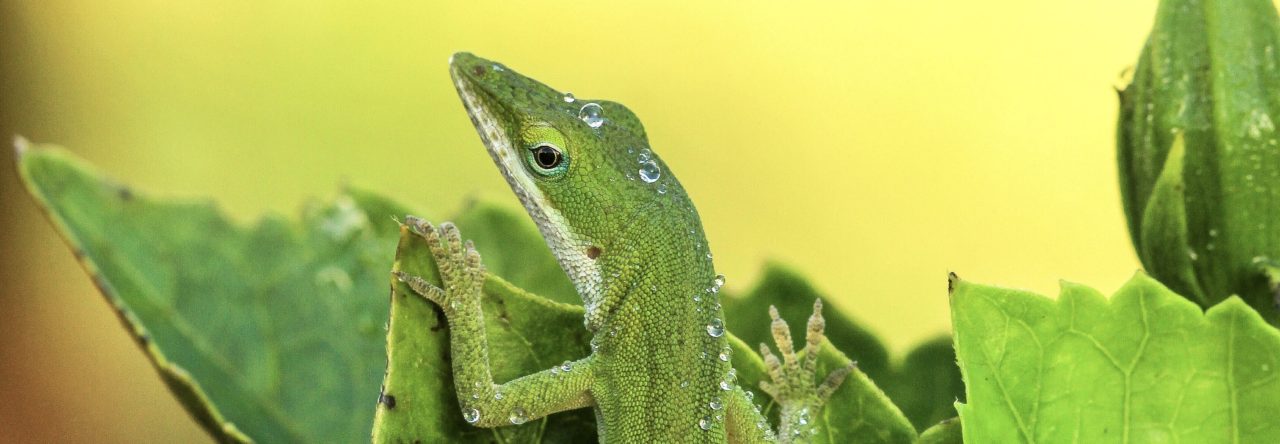
Variation in the back patterns of Anolis sagrei in the Bahamas. From Calsbeek and Cox (2010).
![]()
Last year, we had a series of posts discussing the evolution of dorsal patterns of female anoles, as well as several studies that reported intrapopulation variation in female patterning. Why such variation should exist is a mystery, and studies on both A. humilis in Costa Rica and A. sagrei in the Bahamas failed to find evidence that natural selection was acting on this variation.
Now, Calsbeek and Cox report an experimental study of natural selection on dorsal pattern on small islands in the Bahamas. They introduced anoles with the three patterns shown on the left onto four small islands. Two of the islands had birds and snakes, the other two had neither. One predator-exclusion island was studied in 2008, the other three in 2009. In addition, the authors measured selection in a natural population over the course of four years.
The major result of the study is that not only was survival reduced on islands with predators, but also in the presence–but not absence–of predators, the intermediate diamond-bar pattern had higher survival than the other two patterns. How this intermediate pattern leads to heightened survival is not clear, and the authors propose a few hypotheses for future testing.
R. CALSBEEK & R.M. COX (2012). An experimental test of the role of predators in the maintenance of a genetically based polymorphism Journal of Evolutionary Biology DOI: 10.1111/j.1420-9101.2012.02589.x
- Evolution in Real Time on Lizard Island - March 23, 2025
- Spider Snags Adult Anolis osa - March 22, 2025
- An Homage to the Green Anoles of New Orleans - March 21, 2025


Pat Shipman
So, a simple further test of this hypothesis would be to go to yet another island (like Little Cayman), which has snakes, predators (birds, cats) and A. sagrei, and see which if any pattern predominates. Or, possibly if all of the sagrei have a single pattern. I’ll put that on my check list for this winter!
cybokat
Without having read the paper, and without being a crack in pop. genetics – did they consider the possibility that the outcome was influenced by scientist-based nonrandom selection of the founder populations for each island, independently of those individuals’ founder dorsal pattern?
This definition says it better than me:
Genetic Transilience: is based on a strongly epistatic system with a few major genes. This results in multiple adaptive peaks (see Wright’s Shifting-Balance Process), and speciation is brought about by a non-selective process causing a peak shift.
cybokat
just that it wouldn’t be “speciation” in this example but “pattern fixation”
Skip Lazell
We have great pattern variation in female and juvenile A. cristatellus right here on Guana, BVI, and snakes, kestrels, night-herons, thrashers, iguanas, and more that eat anoles.
Pat Shipman
I am now on Little Cayman & trying to document proportions of different back patterns on A. sagrei in the presence of another anolis (maynardi), and snakes, barn owls, and dogs & cats. I am finding a fair number of sagrei with NO light pattern on their backs at all. Can anyone advice me how to avoid counting the same sagrei individuals twice (or more)? I certainly don’t want to catch & confine them all. Also, not being a herpetologist but only an interested amateur, am I being fooled by a sagrei ability to change color selectively? The patternless ones do not seem to be dark overall (which I might expect from a color change due to fear or something) but rather sort of slightly mottled brown, sometimes with a reddish head.
Jonathan Losos
Pat, it is true that sagrei can change color from lighter to darker, and sometimes when they blanch, the patterns on females fades away. So that could be part of the issue. As for how to avoid double counting, that’s a tough one w/o catching them. One way to mark lizards for a mark-recapture study is to spray them with a spray gun full of non-toxic paint, but that’s probably more effort than you want to make, and makes a mess, too (use water-based paint so it won’t be permanent!). I suppose another possibility would be to take pictures and try to look for individual differences in patterns–again a lot of work and doesn’t help with the patternless ones. Adults are generally territorial, so they should be in the same general area, which might help to decide whether one that looks familiar has been seen before. Sorry I don’t have better ideas!
Pat Shipman
I am having a fascinating time trying to document the A. sagrei back patterns here in Little Cayman. I guess I am pleased I hadn’t missed an obvious method for telling one from another — and of course the ones I see most are around our house. There are definitely ones with the bar pattern and definitely some with the diamond pattern. I note it is hatching time in the Glor lab & there certainly is a good number of babies here too. Do patterns remain stable over a lifetime? I am assuming so.
Jonathan Losos
I suspect the patterns are constant through life, too, but I don’t think anyone has ever investigated this.
Pat Shipman
Here is a photo of A. sagrei upside down on a plant. As far as I can tell, this anolis has no back pattern. I don’t think I am mis-identifying this anolis; it is about 12″ from the ground and does not have a maynardi-type nose.
Jonathan Losos
it seems to me that I can faintly see the outlines of the “diamond” pattern–i.e., repeated, sometimes diamond-shaped, sometimes blob-shaped, items that repeat down the back. Clearer around the pelvis. My guess is that this is the pattern it has, but for some reason it has blanched a bit.